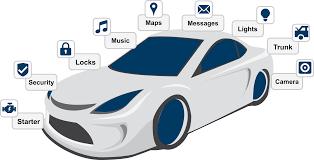The overall automotive IoT market is projected to reach USD 82.8 billion by 2022 from USD 20.0 billion in 2016, growing at a CAGR of 26.7% during 2016-2022. The study involved four major activities to estimate the current market size automotive IoT market. Exhaustive secondary research was done to collect information on market, peer market and parent market. The next step was to validate these findings, assumptions, and sizing with industry experts across value chain through primary research. Both top-down and bottom-up approaches were employed to estimate the complete market size. Thereafter market breakdown and data triangulation was used to estimate the market size of segments and subsegments.
Secondary Research
In the secondary research process, various secondary sources have been referred to for identifying and collecting information for this study. The secondary sources include annual reports; press releases; investor presentations of companies; white papers; journals & certified publications; and articles from recognized authors, websites, directories, and databases among others.
Primary Research
In the primary research process, various primary sources from both supply and demand sides have been interviewed to obtain qualitative and quantitative information for this report. Primary sources from the supply side include industry experts such as CEOs, vice presidents, marketing directors, technology & innovation directors, and other executives of various key companies and organizations operating in the automotive IoT market. Approximately 40% and 60% primary interviews have been conducted from the demand side and supply side, respectively.
In-vehicle communication to hold the largest share of the automotive IoT market
In-vehicle communication is used to provide accurate route information to a user while on road and also update the road-traffic controller with detailed information about the conditions on a road. Road users receive information such as up-to-date travelling times and the maximum speed limit. They also receive warnings in case of accidents or other incidents. This way, in-vehicle communication offers users an option to choose their route based on relevant and up-to-date information.
Infotainment application to drive the growth of the automotive IoT market
GOT NEWS? click here
Google News, Bing News, Yahoo News, 200+ publications
The introduction of cloud-based services for music and other multimedia support such as games led to increase an infotainment application in vehicles. Users look for multimedia support and smart apps for device integration, high-speed connectivity, intuitive and multi-modal user interfaces in the systems installed in vehicles. Internet radio, streaming music, and social networking apps are the services which are commonly available.
North America to hold the major market share for the automotive IoT market during the forecast period
North America, which comprises the U.S., Mexico, and Canada, dominates the global automotive IoT market. It is expected that the growth in the region would be the largest with regard to one of the major application areas of connected vehicle vehicle to X communication. Also, the demand for cars has witnessed a boost recently with the convergence of the ICT sector, the automotive sector, and the transportation sector resulting in the emergence of the connected vehicle ecosystem.
The major players in the automotive IoT market are Texas Instruments Inc. (U.S.), Intel Corporation (U.S.), NXP Semiconductors N.V. (Netherlands), TOMTOM N.V. (Netherlands), IBM Corporation (U.S.), Cisco Systems Inc. (U.S.), Microsoft Corp. (U.S.) ,Thales SA (France), AT&T Inc. (U.S.), Vodafone Group (U.K.), Robert Bosch GmbH (Germany), Google Inc. (U.S.), Apple Inc. (U.S.), General Motors (U.S.), Audi AG (Germany) , Ford Motor Company (U.S.).







